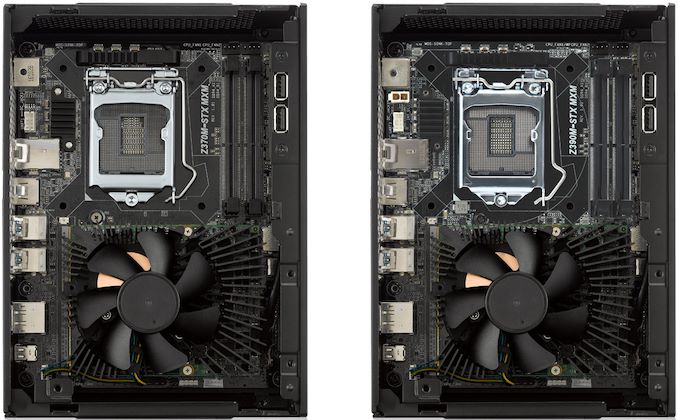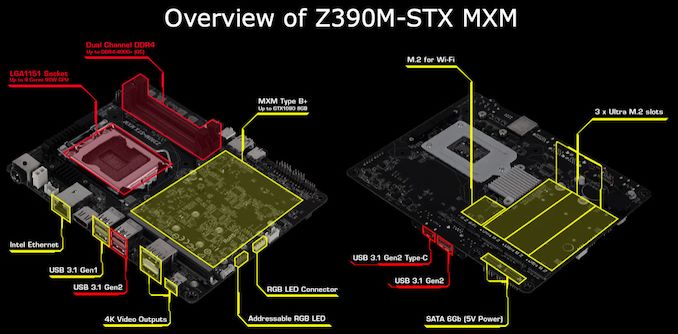ASRock's Super Tiny DeskMini GTX Z390: Up to 9900K with MXM GPU
by Anton Shilov on November 26, 2018 4:00 PM EST- Posted in
- Desktop
- Intel
- ASRock
- NVIDIA
- micro-STX
- MXM
- DeskMini
- Coffee Lake
- Core 9th Gen

ASRock has recently introduced its new DeskMini GTX system that combines high-performance components and miniature Micro-STX form-factor. The new DeskMini GTX Z390 supports Intel’s eight-core processors, up to DDR4-4000+ memory, and NVIDIA’s GeForce GTX 10-series GPUs. As additional bonuses, the latest SFF PC also features two USB 3.1 Gen 2 headers and two RGB connectors.
As the name suggests, the ASRock DeskMini GTX Z390 is based on a motherboard running Intel’s Z390 chipset and featuring multiple enhancements compared the previous generation ASRock DeskMini GTX Z370. The new SFF PC supports Intel’s processors with up to 95 W TDP, including the top-of-the LGA1151 range Core i9-9900K. Also upgraded is the power delivery - in a bid to ensure stable operation of Intel’s latest CPUs and increase overclocking potential of memory subsystem to DDR4-4000+, the Z390M-STX MXM motherboard design features a 5+1-phase CPU VRM compared to the 3+1 design on Z370. The new DeskMini GTX Z390 also has two USB 3.1 Gen 2 ports supporting up to 10 Gbps speed: a Type-C on the front and a Type-A on the back.
When it comes to expandability, just like before, the new Z390M-STX MXM motherboard has an MXM Type B+ slot supporting up to NVIDIA GeForce GTX 1080 8 GB graphics modules. As for storage, the DeskMini GTX Z390 has three M.2 slots supporting PCIe 3.0 x4 SSDs as well as two 2.5-inch bays for various storage devices.
General connectivity wise, the Z390-based DeskMini GTX features a 802.11ac Wi-Fi + BT module (optional), Intel I219V-based GbE, USB 3.0 Type-A, USB 3.0 Type-C, multiple display outputs (one HDMI 1.4, one HDMI 2.0, one mini DisplayPort 1.4, one DisplayPort 1.4), 3.5-mm audio jacks, etc.
ASRock will offer two versions of the DeskMini GTX Z390: one with NVIDIA’s GeForce GTX 1060 6 GB GDDR5 module and a 220 W external PSU, another equipped with NVIDIA’s GeForce GTX 1080 8 GB GDDR5X and a 270 W external power supply. Both systems are already listed at the manufacturer’s website, so expect them in retail in the coming weeks.
In addition to the DeskMini GTX Z390, ASRock also added the DeskMini GTX B360 to the lineup. The latter also has a 5+1-phase CPU VRM and supports Intel’s 8th and 9th Gen Core processors with up to 65 W TDP, but naturally does not support overclocking and some other perks of the enthusiast-class machine (e.g., less PCIe lanes, so different M.2 configuration; no aRGB header, etc.).
Related Reading
- ASRock Jupiter: 1 Liter UCFF PCs with Six-Core Coffee-Lake CPUs
- Shuttle Announces 1.3-Liter XPC Slim DH310: A Barebones PC for Coffee Lake CPUs
- ASRock at CES 2018: Micro-STX DeskMini GTX PC Gets Coffee Lake
- ASRock Upgrades Beebox-S SFF PCs with Kaby Lake CPUs
Source: ASRock












11 Comments
View All Comments
romrunning - Monday, November 26, 2018 - link
Get a TB3 port in it, and you've pretty much covered all of the connectivity bases.Still, have to say - I like it!
rhysiam - Monday, November 26, 2018 - link
It's important to highlight that there's almost no way a 9900K in this system will be allowed to run at PL2 (all core turbo clocks), at least not for more than a handful of seconds. While it's impressive to get a high clocked 8C/16T CPU in such a tiny form factor, it's going to be pretty constrained. You won't get the sort of performance out of it that we've seen from most 9900K launch reviews on high end motherboards with less constrained power settings.igavus - Tuesday, November 27, 2018 - link
Not to mention that it'll scream like hell if you try to use that performance. I mean, they haven't even published the noise measurements - which is really important if you're placing it anywhere near you.Valantar - Tuesday, November 27, 2018 - link
Considering that it is a barebones kit and thus doesn't include a CPU, RAM, boot drive or CPU cooler, noise measurements would have been rather hard to get a hold of ...igavus - Tuesday, November 27, 2018 - link
The only thing there adding noise would be the CPU cooler and the external PSU, so.. just provide a recommended configuration ( considering that the cooler needs to fit.. ) and measure that. Not hard.OremLK - Monday, November 26, 2018 - link
My problem with these types of mini-barebones/prebuilts is that they usually include a large external power supply brick, which somewhat defeats the purpose of having a tiny system in the first place. Manufacturers, find a way to build a small custom power supply into the case! The whole reason for these to exist is to save on space and clutter.CharonPDX - Monday, November 26, 2018 - link
Yeah, 270W power brick will be gigantic.firewolfsm - Tuesday, November 27, 2018 - link
Well there's a clear trade off, the box will grow in size. Having an external power brick allows the box which actually sits on the desk to be tiny, which in some sense is more important than a brick hidden under the desk. Also, by separating heat caused by the power supply the load on the computer's cooling might be reduced.Spunjji - Tuesday, November 27, 2018 - link
This. Trying to dissipate that hat effectively from within a small chassis will require more fan noise, too, so you pay twice in terms of system size and noise levels. There's a reason most manufacturers go with this approach!OremLK - Wednesday, November 28, 2018 - link
I find it hard to believe that a passively-cooled external power brick would perform better on thermals than an actively-cooled internal one (perhaps with a shroud and separated intake/exhaust grills). Yes, obviously the case would have to be a little bigger, but it seems worth it to me. Those external power bricks are incredibly clunky and much more of a pain than just adding slightly more volume to the case.